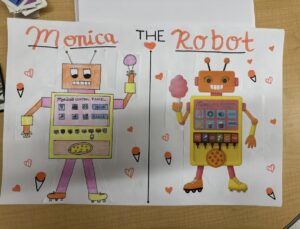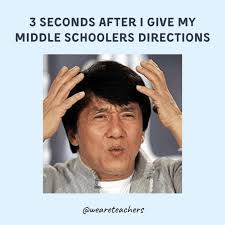Memes, Mixes & Meaning: Teaching in the Digital Age
(A 6/7 Teacher’s Take on Digital Culture & Learning)

Life in a Digital Classroom
As we are all aware, the digital world is constantly changing and I feel as though I am always trying to keep up with the next trend or meme. As a younger middle years teacher, you think it would be easy for me to keep up with these kinds of things, but nope. To this day, I still do not understand the whole “67” meme”. Let me tell you, it is NOT the year to have a 6/7 split homeroom classroom… Between TikTok trends, AI, memes, and everything in between, today’s students are growing up in a world where information moves faster than ever before. As a 6/7 teacher, I see firsthand how connected my students are to this digital culture.
Honestly, I don’t use AI or digital tools with my students every day. But I recently tried something new in my ELA class, and it was a hit! We were reading “Ungifted” by Gordon Korman, and I asked students to design their own unique robot. They used descriptive writing to explain their robot’s features, then used ChatGPT to turn their drawings into realistic AI-generated photos. The students were blown away seeing their creations come to life. It made writing so much more meaningful (and honestly, so much more fun). Other than that, I mainly use AI for my own planning and creative ideas, but this experience reminded me how powerful digital tools can be when used intentionally.

Memes as Modern Meaning-Makers

Let’s be real- memes are their own language now. My students use them to communicate emotions, opinions, and even sarcasm in ways words alone can’t. Instead of trying to stop or fight against them, I think we as teachers can bring memes into the classroom to connect with how kids already think and share ideas.
For example, I used memes throughout one of my class read-aloud novels last year, “Middle School: The Worst Years of My Life” By: James Patterson. Instead of giving students the traditional handout chapter comprehension questions, I had them make 2-3 relevant memes each week that would summarize a moment from what I had read aloud to represent the chapters I would have read. The kids loved it!
But memes can also open up deeper conversations. Although most memes are funny, not every meme is harmless or even accurate as some can spread misinformation. Having students critically analyze memes could help them think about why something is funny, who it’s for, and what message it really sends.
Coming back to the whole “6-7” meme that I mentioned earlier, I recently saw on Facebook a teacher who had posted a “Six Seven” student assignment. I think it is hilarious and the perfect blend of meme culture and classroom creativity. Students are asked to write exactly 67 words in 6-7 minutes about what the meme “six seven” even means. I need to try this with my students right away! It’s short, funny, and completely shareable, just like a meme. What’s great about it is how it turns a social media trend into a learning opportunity that focuses on creativity and participation. It’s a great example of how something viral can become an engaging writing challenge that fits right into today’s digital culture.
Remix Culture: Students Become Creators
Social media platforms such as Tik Tok and YouTube have completely changed how young people learn. Students aren’t just consuming information anymore, they are mixing it, recreating it, and are sharing their own versions of it. From our EC&I 831 course lecture the other evening, I learned that this is called participatory culture, the idea that everyone can be a contributor, not just a learner. Some teachers really embrace this and use this as part of their teaching style and instructional practices, while other teachers want nothing to do with it. I could have students become creators in my very own classroom such as after a science lesson, my students could create a short video explaining vertebrates and invertebrates using a trending TikTok sound, or make a funny “before and after” meme of what happens when an ecosystem loses a species. Projects like this give students ownership and let them show their understanding of concepts and ideas in creative ways. As Henry Jenkins explains, “Participatory culture shifts the focus of literacy from individual expression to community involvement” (Jenkins et al., 2009, xiii). As teachers, we can teach students how to use digital tools safely and responsibly.

Teaching in the digital age can definitely be both exciting and overwhelming. But at the end of the day, our students are growing up in this world, and not outside of it. Whether it’s through memes, remix projects, or digital storytelling, our goal isn’t to keep up with every trend, but rather it’s to help students learn how to think, question, and create in the world we all live in.
To end things off, I wanted to share this video where Henry Jenkins explains participatory culture. It really helped me think about how students can move from just consuming content to making meaning with it.
Note: I used OpenAI’s ChatGPT to brainstorm heading ideas for this post and to learn more about Henry Jenkins work on “Participatory Culture”. All final writing, reflections, and examples are my own.
References:
Jenkins, H., Purushotma, R., Weigel, M., Clinton, K., & Robison, A. J. (2009). Confronting the challenges of participatory culture: Media education for the 21st century. The MIT Press.
Jenkins, H. (2013, May 7). Participatory culture [Video]. YouTube. https://www.youtube.com/watch?v=1gPm-c1wRsQ
OpenAI. (2025). ChatGPT [Large language model]. https://chat.openai.com
Thank you for reading!
-Mr. Jordan Schutz (The 6/7 Teacher)
5 thoughts on “Memes, Mixes & Meaning: Teaching in the Digital Age”
Jordan, I can completely relate to that feeling of constantly trying to keep up, and failing miserably. I didn’t even know what any of the current “Brainrots” were until I asked my eight-year-old, and he rattled them off like it was common knowledge. I also just learned who Bad Bunny is (and apparently he’s playing the Super Bowl?). It really drives home how quickly digital culture moves, and how even those of us who consider ourselves fairly tech-savvy can feel a step behind.
What I like about your post is how you lean into that instead of resisting it. You’re showing students that their digital worlds have a place in the classroom and that memes, AI art, and participatory culture aren’t distractions, but new forms of storytelling and self-expression. That’s such a powerful form of cultural responsiveness. You’re meeting students where they are and helping them connect their lived digital experiences to learning in meaningful ways.
Your point about memes and misinformation is also spot-on. This is where critical digital literacy becomes essential. Helping students think about who creates a meme, whose voice it represents, and who might be left out of the joke adds an important layer of analysis. Memes can be funny, but they also carry messages about identity, belonging, and sometimes bias. Encouraging students to unpack that and to question what’s being communicated and why can turn everyday media into a site of critical thinking.
I appreciate how you frame memes and digital trends as cultural texts rather than nuisances. It reminds me that part of our role as educators is to help students not just consume content, but interpret it, challenge it, and create responsibly within it. That’s what digital citizenship really looks like, it’s not just being “safe online,” but being thoughtful, creative, and critical participants in the digital culture they’re growing up in.
Hello Matthew,
Thank you for the reply! I swear I learn half of my “digital pop culture” from my students too. They are constantly teaching me new slang, songs, and memes that I didn’t even know existed. I actually laughed when you mentioned Bad Bunny because I only found out who he was after one of my students used him as an example in a writing piece last year!
You’re completely right about how fast everything moves online! It really is impossible to keep up with it all. I think that’s why I’ve tried to shift my mindset from “keeping up” to just leaning in and learning alongside my students, like you said. When we make space for their digital world in our lessons, it really does change the energy in the room. They get excited to share, and it becomes more about connection rather than about control.
I love how you mentioned memes as “cultural texts.” Thats such a great way to put it! I’ve definitely seen how memes, TikToks, and even viral jokes carry so much hidden meaning and it gives students the tools to unpack them which is an important part of digital citizenship.
Hey Jordan,
I absolutely loved reading this! Your post perfectly captures the chaos and creativity of teaching in today’s digital age — memes, TikToks, AI, and all. The way you turned the “Ungifted” robot project into a mix of writing and AI art was such a clever way to blend imagination with technology. And that “67” meme idea? Brilliant! You’ve shown how teachers don’t need to chase trends but can remix them into meaningful learning. Your reflection really highlights how digital tools can transform classrooms into spaces where students aren’t just learning — they’re creating, laughing, and thinking critically. Honestly, your approach makes the digital world feel a lot more human.
Thanks so much, Amandeep! That means a lot. Chaos and creativity completely does sum up teaching perfectly, especially with a bunch of 6/7s haha! The robot project was so fun to watch come to life and the kids were so proud seeing their drawings being turned into real images.
I’m glad you liked the “67” idea too! It’s such a simple but yet funny way to turn what’s trending into learning. I totally agree with you in saying that we don’t need to chase every trend, but using a few of them definitely helps keep students engaged and excited to learn. Thanks again for the kind words!
Hi Jordan,
I really enjoyed reading your post, your insight made it a really engaging reflection. I totally relate to feeling like we’re “always trying to keep up” wiht the next trend. Your “ungifted” robot activity was such a fun way to involve descriptive writing with AI visualzation. I can imagine how motivating that must have been for your students to see their ideas come alive. I also enjoyed your take on means as modern meaning makers. You are right that having memes to summarize chapters is a cool twist on comprehension. I reflected in my own post about a teacher of mine who had us make memes about WWI. Your discussion on participatory culture connected well with Jenkin’s work. When students remix knowledge through videos, memes, or trends it really gives them to ability to transform from consumers to co-creators of their own knowledge. I think you captured really well what it is like to teach in a digital age!